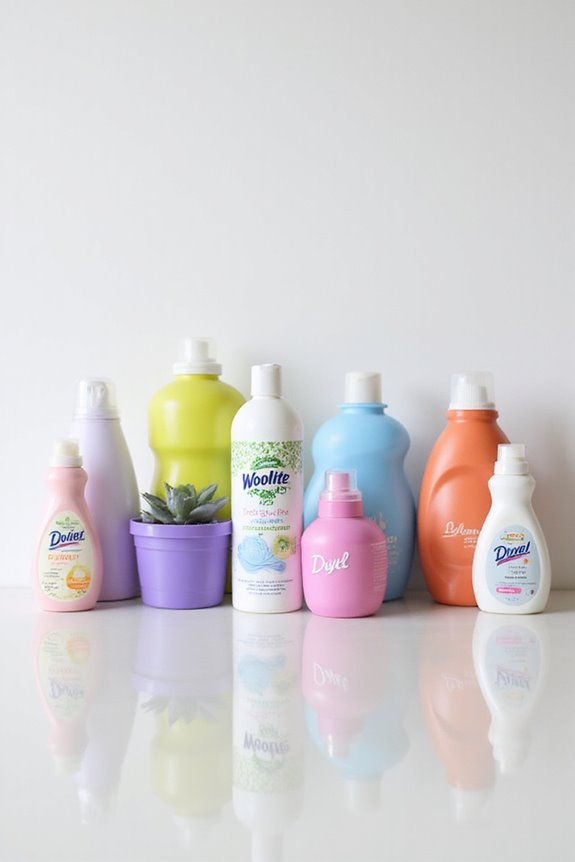We all dread stains on our clothes, but don’t panic! Let’s start by blotting the stain instead of rubbing—it spreads like gossip! For grease, we can use dish soap to break it down. Liquid dish soap mixed with hydrogen peroxide works wonders for wine stains. For adhesive, soak in soapy hot water and scrape gently. Remember, testing on hidden seams is key. Got your favorite stain-fighting products? Stick around, we’ve got more tips to tackle those pesky stains!
Key Takeaways
- Always start by blotting the stain gently to absorb excess liquid without spreading it.
- For liquid stains, soak the area in cold water and apply a diluted shampoo and vinegar mix.
- Act quickly on grease stains by blotting and using liquid dish soap to break down the oils.
- For adhesive stains, soak in soapy hot water and gently scrape off the residue after 30 minutes.
- Use oxygen bleach or vinegar solutions for dye-based stains, avoiding heat until the stain is completely removed.
Common Stain Removal Techniques
When it comes to tackling stains on our clothes, we’ve all faced a few common challenges. For effective stain removal, we should always start by blotting the stain, not rubbing it—rubbing can spread it further. If there’s excess food or gum, let’s scrape that off first. We’ve found that making a baking soda paste can help with sweat and fruit stains, while dish soap mixed with hydrogen peroxide works wonders on wine stains. Remember to test any stain removal agents on a hidden seam to protect our fabric care. After applying our pretreatment, letting it sit for the recommended time is essential. Additionally, using a specialized product like Shout Active Enzyme can enhance our stain removal efforts significantly. In the end, patience pays off, and our clothes will thank us!
Removing Liquid Stains
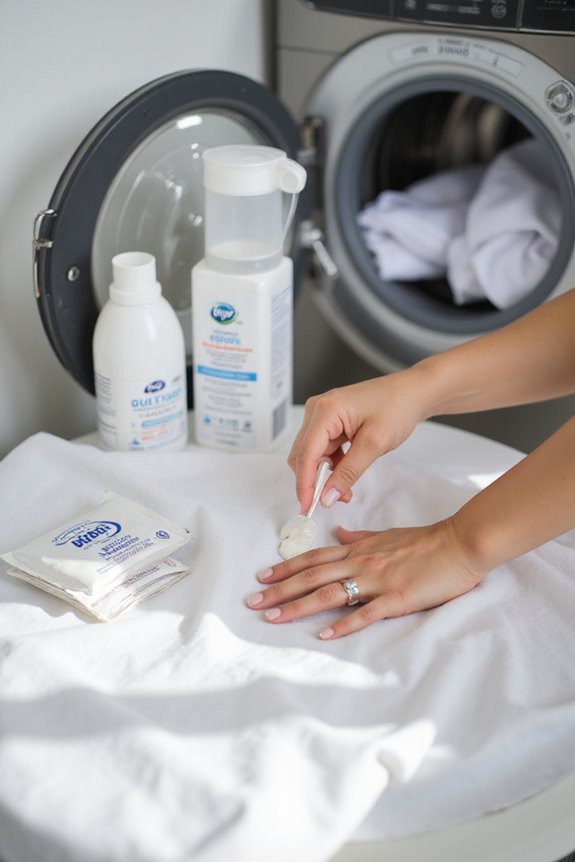
Liquid stains can feel like a nightmare, especially when they happen right before an important event. The first step we should take is the blotting technique—using a clean cloth to absorb as much liquid as possible. Next, soaking the stained area in cold water is key for many stains, like coffee or wine. Chemical treatments can follow; for tannin-based stains, we’ve found that a mix of diluted shampoo and white vinegar works wonders. Glycerin is our go-to for tougher stains like red wine. Don’t forget to wash items separately, using cold water first to avoid setting the stain. If it’s still there after washing, let’s repeat the process—heat can make stains permanent! Additionally, using enzyme-based formulas can significantly improve your chances of removing tough stains like blood.
Removing Grease and Oil Stains
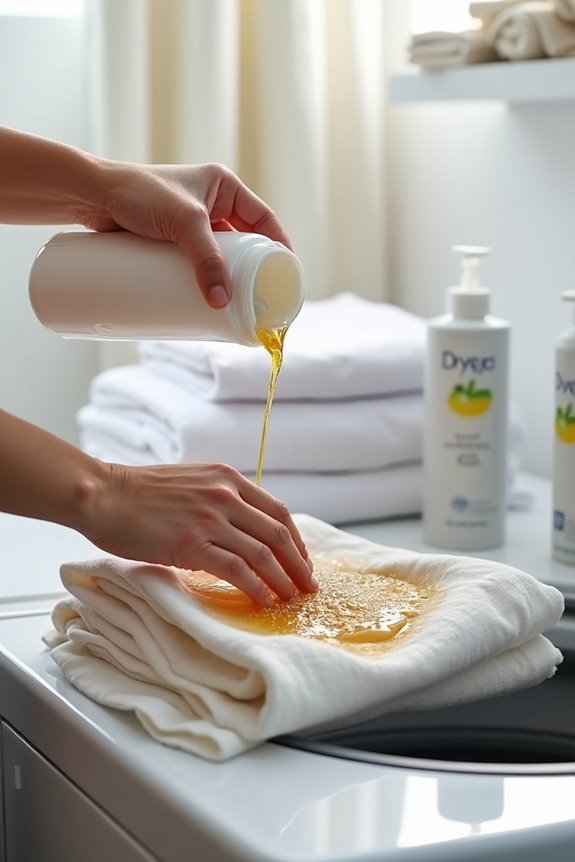
Stains from grease and oil can be a real headache, especially if we’re trying to keep our favorite clothes looking sharp. First, let’s act fast! Blot the grease with a clean cloth to prevent it from setting. We can use liquid dishwashing soap, which is great for breaking down oils. Just rub it gently into the stain before rinsing with warm water. For extra grease absorption, applying liquid laundry detergent directly to the stain works wonders. If the stain’s stubborn, try a bit of cornstarch to draw it out. Remember, avoid heat until the stain’s gone—nobody wants a permanent reminder of that delicious meal! With these stain treatments, we’ll be back in our favorite outfits in no time. Additionally, using a specialized grease stain remover can significantly enhance the chances of complete stain removal.
Removing Adhesive Stains
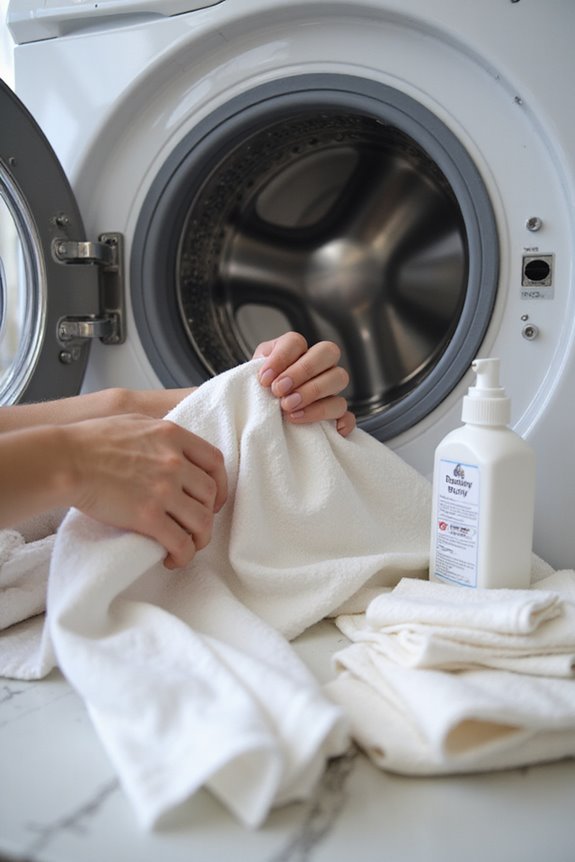
Adhesive stains can feel like little monsters stuck to our clothes, but don’t worry—there are some effective ways to tackle them! For adhesive removal, we can start by mixing soap and hot water, then soaking the garment for about 30 minutes. This helps loosen the sticky residue. Next, gently scrape it off with our fingers or a plastic scraper.
If that doesn’t work, we can use rubbing alcohol or white vinegar. Just dab a cotton ball in the solvent and let it do its magic for a few minutes. For tougher stains, acetone can save the day, but let’s test it first to avoid any fabric mishaps. Remember, patience is key! Happy cleaning!
Removing Dye-Based Stains
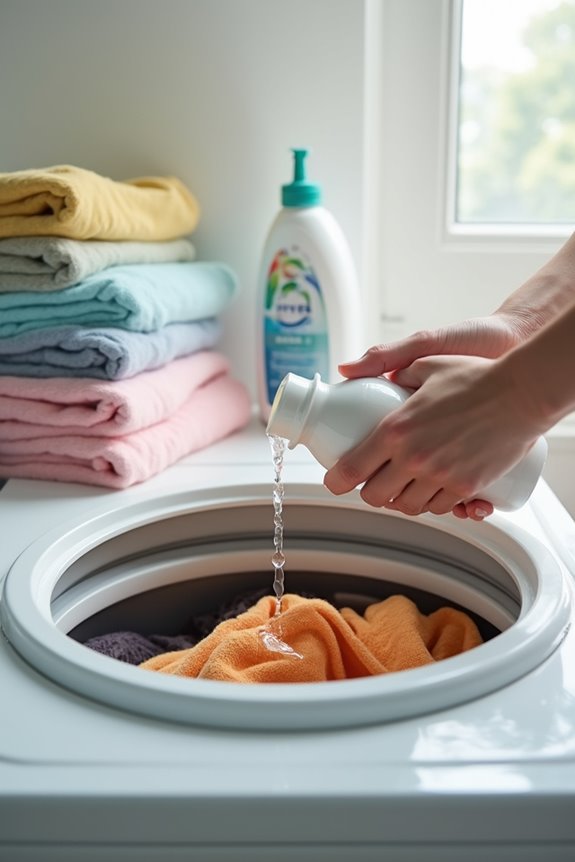
Sometimes, it feels like dye-based stains are on a mission to ruin our favorite clothes. These stains often come from dye transfer, which happens when colors bleed from one fabric to another. To tackle these sneaky stains, we recommend using oxygen bleach, like OxiClean, which is gentler than chlorine bleach and safe for colored fabrics. For stubborn stains, RIT Color Remover is a great option.
If we act quickly, soaking the stained item in a vinegar solution can help break down the dye. Remember, let’s avoid using heat until the stain is completely gone, as heat can set the stain. Additionally, using a detergent with oxygen-based cleaning power can enhance stain removal for a more effective solution. With a bit of patience and the right products, we can restore our clothes to their former glory!
Removing Protein and Organic Stains
When it comes to tackling those tricky protein and organic stains, we’ve got to act fast to keep them from becoming permanent residents on our favorite clothes. First, let’s remember that cold water is our best friend here; it helps prevent stains from setting. For protein stain removal techniques, we can soak the fabric overnight in cold water with mild soap or enzyme-based detergents.
If we’re dealing with organic stains, a mix of hydrogen peroxide and dish soap works wonders on whites. After treating, we should wash as usual in cold water. And hey, using a stain removal stick or even a potato can be surprisingly effective! Additionally, using enzyme-based stain removers can significantly enhance the effectiveness of your stain removal efforts. So, let’s get to it and rescue those clothes!
Tips for Stain Prevention
After tackling those pesky protein and organic stains, let’s shift our focus to keeping our clothes looking fresh and clean. One way to achieve this is through effective fabric care. We should consider using water and oil repellent finishes, which create a barrier that considerably reduces stain formation. Plus, they help our clothes dry faster, making stain management a breeze!
Pretreating stains promptly is another trick. Heavy-duty detergents or a simple paste of powdered detergent can break down stains before they set. Remember, never let stained clothes dry out! Using enzyme-based detergents can significantly enhance stain removal effectiveness.
Frequently Asked Questions
Can I Use Bleach on All Types of Stains?
We can’t use bleach on all stains. While it’s effective for some, like organic stains, we should consider bleach alternatives for others. Exploring different stain removal techniques can help us protect our fabrics better.
How Do I Treat Old or Set-In Stains?
When we found a stubborn red wine stain on our favorite tablecloth, we used effective stain removal techniques. By testing fabric care methods, we successfully lifted the stain using vinegar and baking soda. Patience pays off!
Are There Specific Stain Removal Products I Should Avoid?
When considering stain removal products, we should avoid those with poor effectiveness and high costs. It’s vital to assess their chemical reactions and fabric compatibility to guarantee we’re not damaging our clothes while trying to clean them.
How Can I Prevent Stains From Setting in My Clothes?
To prevent stains from setting in our clothes, we should follow effective stain prevention tips, like using fabric protectors, treating stains promptly, and washing garments carefully. Let’s keep our wardrobe fresh with these laundry tips!
What Fabrics Are Most Stain-Resistant?
When exploring stain-resistant fabrics, we find polyester, microfiber, and olefin stand out for their durability and ease of cleaning. Incorporating fabric care practices guarantees these materials maintain their stain-repelling qualities over time.



